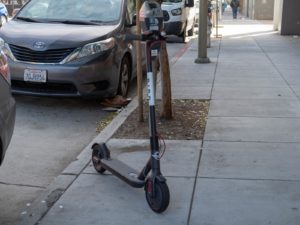Over the past few years, cities across America have experienced sudden downpours of shared electric scooters, piling up almost overnight on curbs, sidewalks and front yards from Atlanta to Los Angeles.

The phenomenon has quickly built billion-dollar startups, a new urban subculture and even a gray market for freelance scooter-chargers. But as with everything new, it’s also triggered litigation. And in the case of a transportation mode that leaves riders exceptionally vulnerable to sudden injury, it’s reasonable to expect a lot of it.
Now, lawyers have their first trickle of data as they seek to make unlucky pedestrians and injured riders whole. A limited study—the first of its kind—reviewed scooter-related injuries of 249 patients at two Southern California emergency rooms between September 2017 and August 2018. The report revealed the kinds of injuries one can expect in this brave new world.
The vast majority of the injured were riders as opposed to pedestrians. They averaged around 34 years of age and were 58 percent male. The study revealed a general lack of operator adherence to traffic laws or warnings by the scooter companies themselves, according to an article published Friday in JAMA Network Open. Though scooters can reach 15 mph, less than 5 percent of riders were reported to have been wearing helmets. About 40 percent of patients had head injuries and almost 32 percent suffered broken bones. The study said a significant subset of the injuries occurred in patients younger than 18.
The researchers don’t try to compare your chances of getting killed on or by a scooter versus a car, but rather the physical damage being wrought. And how did these 249 California riders get hurt, exactly? More than 80 percent just fell off, according to the study. Eleven percent hit something.
Paul Steely White, Bird’s director of safety policy and advocacy, criticized the JAMA study as “very limited.” The report “fails to take into account the sheer number of e-scooter trips taken,” he said.
The scooter model is based on an app. Download it, enter your credit card, find a scooter, scan, ride, and leave it at your destination. For obvious reasons, college campuses have been especially fertile ground for scooter companies, led by Bird Rides and Lime. Some schools and municipalities have impounded swarms of scooters left strewn about, saying they create hazards and parking headaches.
Scooters have already prompted a handful of lawsuits, most notably a proposed class-action in California state court against Bird, Lime and other scooter companies for alleged gross negligence. The complaint was filed in October on behalf of people injured by scooter users, but not on behalf of any the riders. The plaintiffs alleged the scooter makers “knew and/or should have known that their scooters are, would become and would continue to be an unsafe, dangerous and damaging public nuisance.
Bird pointed the finger at automobiles rather than directly addressing the allegations in the complaint. “At Bird, safety is our very top priority, and it drives our mission to get cars off the road to make cities safer and more livable,” the company said. “Shared e-scooters are already replacing millions of short car trips and the pollution that comes with them.”
Lime spokeswoman Mary Caroline Pruitt said the safety of riders and the community is its “number one priority.” The company said it has distributed 250,000 free helmets “across the globe” and is improving the safety of the scooters themselves.
A recent law passed in California, however, allows adults to operate scooters without helmets. To ride most scooters, users must waive liability, which presents a high bar for a subsequent lawsuit. But that doesn’t mean there won’t be lawyers who try.
“A lot of college kids don’t have cars so they love these things,” said Catherine Lerer, whose Los Angeles-based firm filed the class action suit. “People think it looks so easy.”
But suing scooter companies after liability has been waived is a difficult fight, said Tamara Kurtzman, a litigator based in Beverly Hills. “It’s an extremely uphill battle, which is more disappointing because real people are getting hurt,” she said. “That’s the tragedy in this story.”
Lerer said she’s never met a rider who told her they read an e-scooter user agreement. “I’ve been practicing law for 25 years representing personal injury victims,” she said. “I have never seen these kind of devastating injuries before scooters arrived. That’s just what’s shocking to me.” In addition to injured pedestrians hit by scooters, some of her clients were hurt simply tripping over scooters left on a sidewalk, she said.
“You may not know who the rider is if there’s a ‘scoot-and-run’ situation.”
The new study aimed to more fully describe the kind of damage being done. The researchers took great pains to note its limitations, and said they hoped others will build on their data and that policymakers would find it useful as the scooter world expands.
Tyler Haley, a 22-year-old student at James Madison University, said he tried a scooter shortly after they arrived on the school’s Harrisonburg, Virginia campus. He mounted one for a trip from the library to a parking lot, about a mile away. He said the handlebars came loose and he went flying. He said he wasn’t wearing a helmet—and that he hadn’t read the user agreement.
“A whole bunch of people use them,” said Haley, who is not part of the California lawsuit. “I did a front flip over the handles and landed on my shoulder and ended up separating it.”
Kurtzman, the attorney, said that while making a case for injured pedestrians is easier than doing so for a rider, there’s another complication.
“When people get hurt by scooter riders, you may not know who the rider is if there’s a ‘scoot-and-run’ situation,” she said. “People are being injured one way or another. Everyone is madly trying to figure out who pays for it.”
Was this article valuable?
Here are more articles you may enjoy.


 Ineos Recalls 7,000 SUVs After Doors Fly Open While Driving
Ineos Recalls 7,000 SUVs After Doors Fly Open While Driving  California Man Wins $50M in Lawsuit Over Burns From Starbucks Tea
California Man Wins $50M in Lawsuit Over Burns From Starbucks Tea  AAA Study Shows Consuming Cannabis and Driving The Same Day is Common
AAA Study Shows Consuming Cannabis and Driving The Same Day is Common  California Insurance Commissioner Provisionally OK’s State Farm’s 22% Rate Request
California Insurance Commissioner Provisionally OK’s State Farm’s 22% Rate Request 